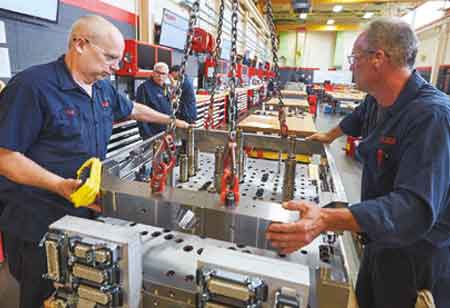THANK YOU FOR SUBSCRIBING

Navigating the Future: Geospatial Technology's Impact on Transportation Design
Matt LaLuzerne, National Director of Business Development and Geospatial Services, McKim & Creed

 Matt LaLuzerne, National Director of Business Development and Geospatial Services, McKim & Creed
Matt LaLuzerne, National Director of Business Development and Geospatial Services, McKim & CreedIn the rapidly evolving transportation sector, geospatial technology has emerged as a transformative force, revolutionizing how transportation systems are designed, managed, and optimized. Geospatial technology, which includes Geographic Information Systems (GIS), light detection and ranging(lidar), and building information modeling (BIM), plays a pivotal role in enhancing efficiency, safety, accuracy, and sustainability across various modes of transportation. This article explores the profound impact of geospatial technology on transportation design and how it is shaping the future of mobility.
Liberating Data from Siloed Systems Using BIM
BIM technology has revolutionized the transportation sector by serving as a collaborative tool that expedites design processes. Integrated with geospatial technology, BIM facilitates enhanced collaboration and coordination among stakeholders, including engineers, architects, and planners. The three-dimensional visualization capabilities of BIM enable stakeholders to make informed decisions, explore design alternatives, and identify and resolve conflicts in real time, significantly reducing the time spent on design iterations.
 BIM's efficiency extends beyond the design phase, offering benefits throughout the entire lifecycle of transportation infrastructure. From optimizing maintenance schedules and monitoring asset conditions to ensuring regulatory compliance and streamlined documentation, BIM's holistic approach enhances transportation systems' resilience, sustainability, and cost-effectiveness. As transportation projects become increasingly complex, the collaboration and efficiency facilitated by the integration of BIM and geospatial technology play a crucial role in the successful and timely execution of innovative infrastructure projects.
BIM's efficiency extends beyond the design phase, offering benefits throughout the entire lifecycle of transportation infrastructure. From optimizing maintenance schedules and monitoring asset conditions to ensuring regulatory compliance and streamlined documentation, BIM's holistic approach enhances transportation systems' resilience, sustainability, and cost-effectiveness. As transportation projects become increasingly complex, the collaboration and efficiency facilitated by the integration of BIM and geospatial technology play a crucial role in the successful and timely execution of innovative infrastructure projects.
Getting Geospatial Data into a Common Data Environment (CDE)
A common data environment (CDE) is crucial for optimizing collaborative workflows and ensuring data consistency. The CDE is a centralized platform that promotes unified data management and provides stakeholders with real-time access to the most accurate spatial information. This streamlined approach enhances collaboration, minimizes errors, and boosts overall efficiency throughout various phases of transportation projects. Most transportation infrastructure project data has a geographic component, meaning it has an implicit or explicit association with a location relative to the Earth. This allows combining a project’s geospatial data with attribute characteristics and temporal information. Location data can be static or dynamic, with several geospatial sensors and computing software that can calculate and monitor positions. A CDE integrates large sets of spatial data from diverse sources in varying formats, including imagery, lidar/point clouds, weather data, cellular data, traffic data, census data, and social media data. Designers can then create adaptable and responsive infrastructure by incorporating live traffic data, weather information, and other dynamic factors. This real-time integration allows for the development of ‘smart’ transportation systems that can adjust to changing conditions and optimize performance continually.
‘The integration of geospatial technology into transportation design represents a paradigm shift, offering unprecedented levels of collaboration, efficiency, and sustainability.’
 Source data can create significant headaches if the data quality and positional accuracies are not managed and governed. Proper data governance and data 'scrubbing' are required to maximize the effectiveness of the CDE and move into geospatial analysis and analytics. Integrating geospatial data into a CDE represents a pivotal advancement in transportation design. This approach fosters collaboration and communication and addresses critical challenges like version control, traceability, and data security. As the transportation sector embraces digital transformation, leveraging a CDE for geospatial data will become indispensable.
Source data can create significant headaches if the data quality and positional accuracies are not managed and governed. Proper data governance and data 'scrubbing' are required to maximize the effectiveness of the CDE and move into geospatial analysis and analytics. Integrating geospatial data into a CDE represents a pivotal advancement in transportation design. This approach fosters collaboration and communication and addresses critical challenges like version control, traceability, and data security. As the transportation sector embraces digital transformation, leveraging a CDE for geospatial data will become indispensable.
Using Geospatial Technology for Transportation Risk Assessment and Resilience
Given the essential role of transportation systems in an emergency response situation, the nation has become more reliant on the overall resiliency of transportation networks. Geospatial technology plays a pivotal role in identifying and analyzing risks associated with transportation infrastructure. By integrating real-time data feeds and historical information, GIS tools can pinpoint vulnerable areas, assess natural disaster risks, and identify potential disruptions to transportation networks. Story maps of historic geospatial data can help engineers and planners integrate design elements to restore normal operations faster in a post-event situation. As the transportation sector evolves, the integration of geospatial technology for risk assessment and resilience becomes a fundamental strategy for ensuring the longevity and reliability of transportation systems in the face of an ever-changing environment.
Changing the Dynamics of Design and Construction
The integration of geospatial technology into transportation design represents a paradigm shift, offering unprecedented levels of collaboration, efficiency, and sustainability. From real-time data integration and digitalization, geospatial technology is shaping the future of transportation infrastructure. As the industry continues to embrace these advancements, we can expect designs that are efficient, sustainable, and responsive to the evolving needs of our dynamic world. The road ahead is paved with innovation, and geospatial technology is steering the way.
Read Also
















ON THE DECK